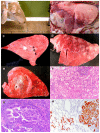Neoplasia-Associated Wasting Diseases with Economic Relevance in the Sheep Industry
- PMID: 33546178
- PMCID: PMC7913119
- DOI: 10.3390/ani11020381
Neoplasia-Associated Wasting Diseases with Economic Relevance in the Sheep Industry
Abstract
We review three neoplastic wasting diseases affecting sheep generally recorded under common production cycles and with epidemiological and economic relevance in sheep-rearing countries: small intestinal adenocarcinoma (SIA), ovine pulmonary adenocarcinoma (OPA) and enzootic nasal adenocarcinoma (ENA). SIA is prevalent in Australia and New Zealand but present elsewhere in the world. This neoplasia is a tubular or signet-ring adenocarcinoma mainly located in the middle or distal term of the small intestine. Predisposing factors and aetiology are not known, but genetic factors or environmental carcinogens may be involved. OPA is a contagious lung cancer caused by jaagsiekte sheep retrovirus (JSRV) and has been reported in most sheep-rearing countries, resulting in significant economic losses. The disease is clinically characterized by a chronic respiratory process as a consequence of the development of lung adenocarcinoma. Diagnosis is based on the detection of JSRV in the tumour lesion by immunohistochemistry and PCR. In vivo diagnosis may be difficult, mainly in preclinical cases. ENA is a neoplasia of glands of the nasal mucosa and is associated with enzootic nasal tumour virus 1 (ENTV-1), which is similar to JSRV. ENA enzootically occurs in many countries of the world with the exception of Australia and New Zealand. The pathology associated with this neoplasia corresponds with a space occupying lesion histologically characterized as a low-grade adenocarcinoma. The combination of PCR and immunohistochemistry for diagnosis is advised.
Keywords: enzootic nasal adenocarcinoma; enzootic nasal tumour virus; jaagsiekte sheep retrovirus; ovine pulmonary adenocarcinoma; small intestinal adenocarcinoma.
Conflict of interest statement
The authors declare no conflict of interest.
Figures



Similar articles
-
Coexistence of enzootic nasal adenocarcinoma and jaagsiekte retrovirus infection in sheep.J Comp Pathol. 2004 Nov;131(4):253-8. doi: 10.1016/j.jcpa.2004.04.005. J Comp Pathol. 2004. PMID: 15511533
-
Nasal adenocarcinoma associated with jaagsiekte sheep retrovirus infection in a sheep.J Vet Diagn Invest. 2020 Jan;32(1):152-155. doi: 10.1177/1040638719897032. Epub 2019 Dec 30. J Vet Diagn Invest. 2020. PMID: 31884891 Free PMC article.
-
Transcriptional Response of Ovine Lung to Infection with Jaagsiekte Sheep Retrovirus.J Virol. 2019 Oct 15;93(21):e00876-19. doi: 10.1128/JVI.00876-19. Print 2019 Nov 1. J Virol. 2019. PMID: 31434729 Free PMC article.
-
Enzootic nasal adenocarcinoma of sheep and goats.Curr Top Microbiol Immunol. 2003;275:201-23. doi: 10.1007/978-3-642-55638-8_8. Curr Top Microbiol Immunol. 2003. PMID: 12596900 Review.
-
Advances in the study of transmissible respiratory tumours in small ruminants.Vet Microbiol. 2015 Dec 14;181(1-2):170-7. doi: 10.1016/j.vetmic.2015.08.008. Epub 2015 Aug 12. Vet Microbiol. 2015. PMID: 26340900 Review.
Cited by
-
Evaluation of the relationship between inflammatory reaction and interleukins in ovine pulmonary adenocarcinomas.Vet Res Forum. 2023;14(1):1-6. doi: 10.30466/vrf.2022.542311.3279. Epub 2023 Jan 15. Vet Res Forum. 2023. PMID: 36816864 Free PMC article.
-
Genomic Sequencing and Analysis of Enzootic Nasal Tumor Virus Type 2 Provides Evidence for Recombination within the Prevalent Chinese Strains.Vet Sci. 2024 Jun 2;11(6):248. doi: 10.3390/vetsci11060248. Vet Sci. 2024. PMID: 38921995 Free PMC article.
-
Retroviral coinfection (Jaagsiekte and Maedi-Visna viruses) in sheep with pulmonary tumors in Transylvania (Romania): retrospective study on 82 cases.Front Vet Sci. 2024 Sep 2;11:1457971. doi: 10.3389/fvets.2024.1457971. eCollection 2024. Front Vet Sci. 2024. PMID: 39286598 Free PMC article.
-
Radiography, CT, and MRI Diagnosis of Enzootic Nasal Tumor in Goats Infected With Enzootic Nasal Tumor Virus.Front Vet Sci. 2022 Mar 11;9:810977. doi: 10.3389/fvets.2022.810977. eCollection 2022. Front Vet Sci. 2022. PMID: 35359686 Free PMC article.
-
Research Progress on Emerging Viral Pathogens of Small Ruminants in China during the Last Decade.Viruses. 2022 Jun 13;14(6):1288. doi: 10.3390/v14061288. Viruses. 2022. PMID: 35746759 Free PMC article. Review.
References
-
- Head K.W., Munro R. Tumours. In: Martin W.B., Aitken I.D., editors. Diseases of Sheep. 3rd ed. Blackwell Science; Oxford, UK: 2000. pp. 381–386.
-
- Else R. Tumors of Sheep. In: Aitken I.D., editor. Diseases of Sheep. 4th ed. Blackwell Publishing; Oxford, UK: 2007. pp. 443–448.
-
- Munday J.S., Brennan M.M., Jaber A.M., Kiupel M. Ovine intestinal adenocarcinomas: Histologic and phenotypic comparison with human colon cancer. Comp. Med. 2006;56:136–141. - PubMed
Publication types
Grants and funding
LinkOut - more resources
Full Text Sources
Other Literature Sources

